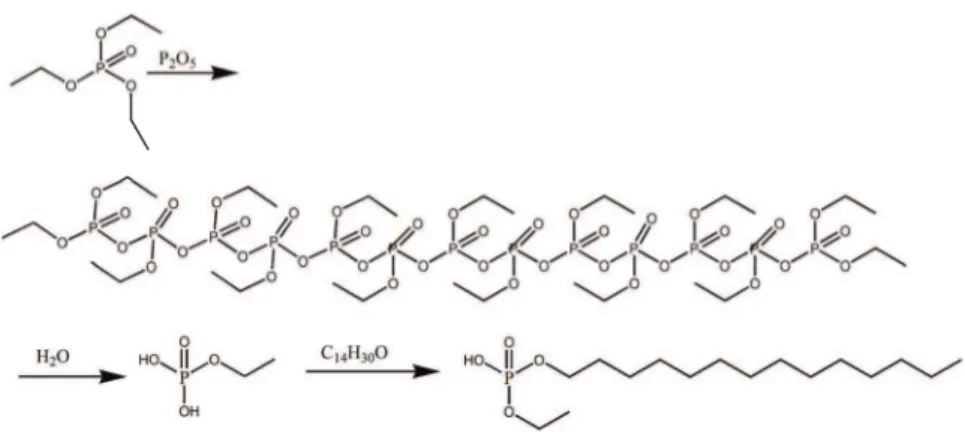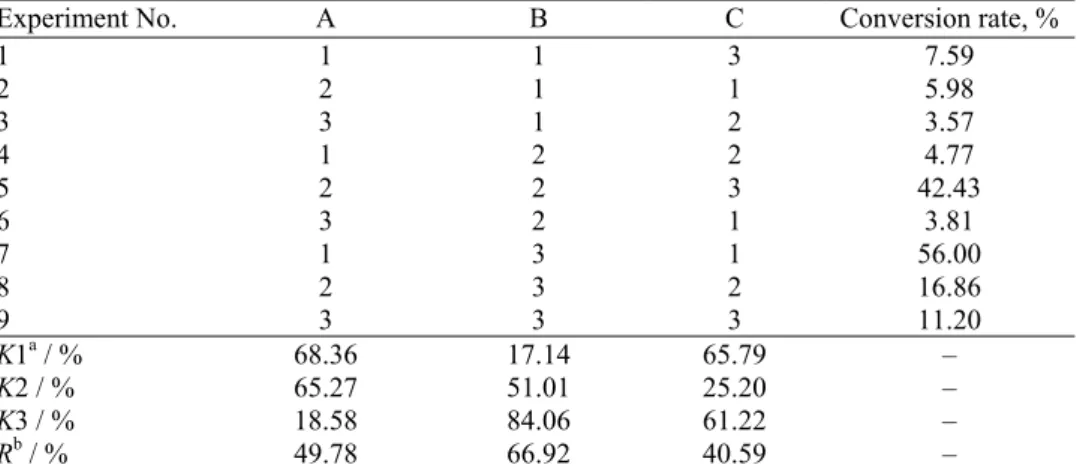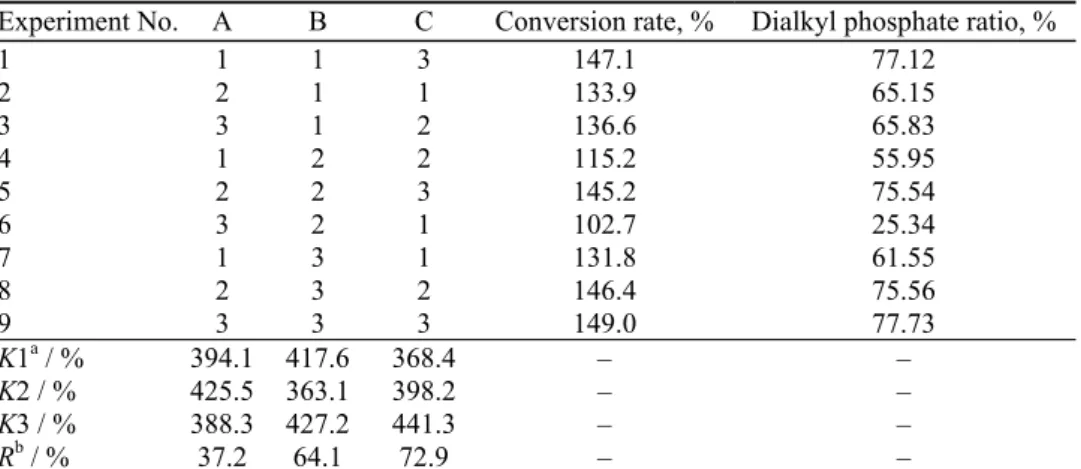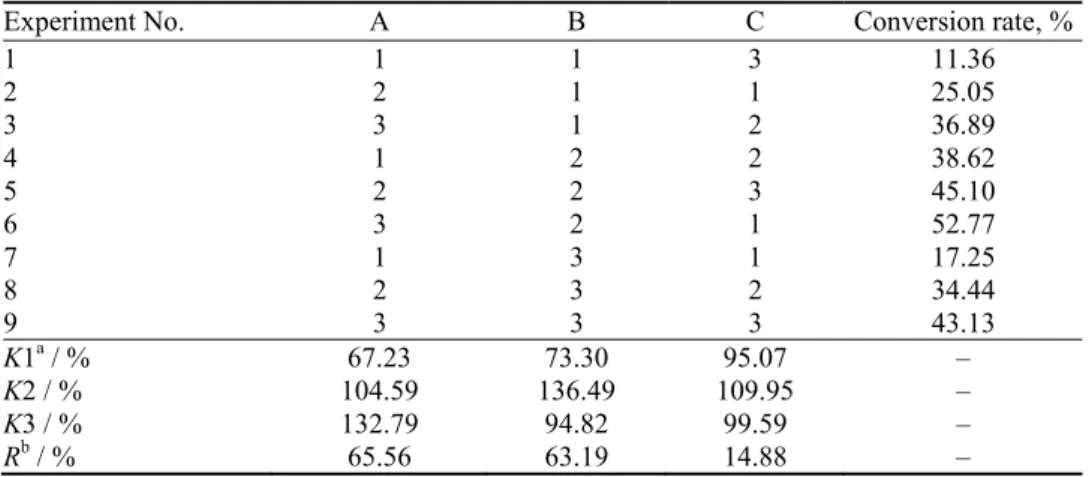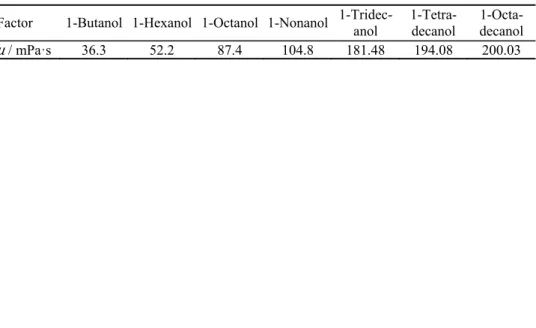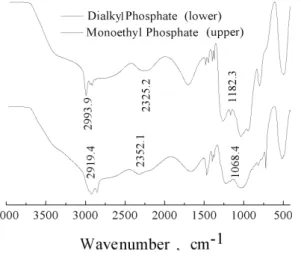JSCS–4898 Original scientific paper
Research of the relationship between the chain length of the dialkyl
phosphate ester and the oil-based fracturing fluid viscosity
JUN LENG1, YI PAN1*, SHUANGCHUN YANG1, SHIDONG WANG1 and ADEWALE ADEBAYO2
1Petroluem Institute, Liaoning Shihua University, No 1, Dandong Road, FuShun, LiaoNing, China and 2Kazan National Research Technological University, ul. Karl Marx 68, Kazan,
Tatarstan, Russia
(Received 14 January, revised 24 March, accepted 30 March 2016)
Abstract: For the usage of dialkyl phosphate as a gelatinizer in oil-based
frac-turing fluids, two methods of preparation are involved. The improved ethyl phosphate method is used to control one of the ester chains by using a single alcohol substitute for mixed alcohols. A new method for polyphosphates is used to control both the ester chains. Different kinds of alcohols are used as the raw materials in a 3×3 orthogonal experiment (ratio of reactants, reaction tem-perature and reaction time) to obtain the optimum reaction conditions. Further-more, 14 kinds of gelatinizers are produced in these experiments. The viscosity of the products is used as an evaluation index. The results based on these two methods showed that there is a positive correlation between the length of the dialkyl phosphate ester chain and the viscosity of the fracturing fluid with a certain number of carbon atoms. In other words, the viscosity of the fracturing fluid increased with an increasing length of the ester chain length. Then the growth slowed down. The viscosity of the products that were produced by the polyphosphate method was visibly improved by 7.72–45.35 % of the level of the other.
Keywords: gelatinizer; ethyl phosphate; phosphorus pentoxide; monoethyl
phosphate;polyphosphate.
INTRODUCTION
In recent years, the yield of conventional oil and gas has shown a downward
trend and hence, countries worldwide have shifted their focus on tight sandstone
gas, shale gas and other unconventional oil and gas resources to increase oil and
gas yields. Such reserves amount to about 1.9×10
14m
3in China,
1which is
doubled the number of conventional reserves. Hydraulic fracturing is a necessary
method to develop these reservoirs. The hydroxypropyl guar gum system is a
common system for water-based fracturing fluids that has a good fracturing
outcome because of its high viscosity. Due to the large quantity of residues after
gel breaking, this fracturing fluid system has a poor effect under low porosity and
low permeability conditions. An oil-based fracturing fluid overcomes the above
shortcomings admirably with no residue after gel breaking. Meanwhile the
char-acteristics of not water sensitive and not acid sensitive gives it obvious
advent-ages during the development of unconventional oil and gas reserves.
2,3In the
study of oil-based fracturing fluids, some researchers
4,5focused on the study of
cross-linking agent, gelatinizer and solubilizer,
i.e
., the usage of new Fe
3+cross-
-linking agents to improve the rate of Al
3+cross-linking, the usage of different
alcohol mixes with benzene and toluene to prepare a gelatinizer with increased
viscosity
6and the usage of a Fe
3+complexing cross-linking agent to improve the
cross-linking rate by increasing the dispersion of Fe
3+.
7Gelatinizers play an
imp-ortant role in oil-based fracturing fluids, when gelatinizer bonds with the cross-
-linking agent, basing oil will be thickened and the viscosity will be increased.
They can also play the role of a drag reducer in the processes of injection and
backflow.
6–9This paper is focused on dialkyl phosphate. Using two methods, the ester
chain type of the gelatinizer could be controlled and the length of the ester chain
determined, and hence, the relationship between the ester chain length and the
viscosity of the oil-based fracturing fluid could be found. The ethyl phosphate
method is the current method. It was proposed by Huddleston
10and used by
Kong
et al
.,
6Hou
et al
.,
7Smith and Persinski,
8Chu
et al
.,
11Wang
et al
.
12and
Wang
et al
.
13to prepare dialkyl phosphate in their studies of oil-based fracturing
fluids. However, the use of mixed alcohols in this reaction has two limitations:
first, the reaction temperature cannot be the optimal reaction temperature for all
of the alcohols, which leads to incomplete reaction. Secondly, the product variety
and the concentration of all kinds of products cannot be determined. Thus, the
kinds of products that play a critical role in the final performance of fracturing
fluids cannot be known either. Due to the above-mentioned limitations, the
cur-rent method – an improved ethyl phosphate method – was remodified in the
present study by controlling one of the dialkyl phosphate ester chains to
deter-mine the type of products. The polyphosphate method can control both of dialkyl
phosphate ester chains to alleviate the shortcomings of the improved ethyl
phos-phate method.
EXPERIMENTAL
Improved ethyl phosphate method
was ethyl, and the other ester chain was targeted. In another words, this method can only determine one of the dialkyl phosphate ester chains.
The molecular reaction mechanism is given in Fig. 1.
Fig. 1. The mechanism of the improved ethyl phosphate method (taking tetradecyl alcohol as an example).
Preparation and purification of monoethyl phosphate
Monoethyl phosphate was the intermediate for the synthesis of dialkyl phosphates. The 3×3 orthogonal test combined reaction rate, reaction temperature and reaction time to deter-mine the optimum conditions. Then a purification process was used to improve the product quality. Viscosity is an important parameter for an evaluation of the performance of a fract-uring fluid, and when other conditions are constant, the greater the viscosity, the greater the crack.14 Therefore, viscosity was chosen to evaluate the experimental product.
Preparation of monoethyl phosphate. The reaction between (CH3CH2O)3PO and P2O5
was use to generate the polyphosphate, which could be hydrolyzed to a monoester. The con-version rate of polyphosphate would directly affect the quality of the subsequent reactions. After obtaining the optimum reaction conditions by the 3×3 orthogonal test, the mixed tit-ration method was used to determine the percentages of the monoester and the diester.
Purification of monoethyl phosphate. The monoethyl phosphate product contains
mono-ethyl phosphate, dialkyl phosphate, mono-ethyl phosphate and alcohol, the mono-ethyl phosphate and alcohol being impurities.15 Due to the insolubility of monosodium phosphate in water and in organic solvents, the ethyl phosphate and alcohol could be removed by a solid–liquid separ-ation procedure after neutralizing one of the hydroxyls from monoethyl phosphate using sodium hydroxide. Then by acidizing the solid obtained from the previous solid–liquid separ-ation procedure, the phosphate ester was regained. n-Hexane was used to extract the
phos-phate ester. The purified phosphos-phate ester could then be obtained by distillation. Thus, the operation steps were: first, to the products produced under the optimum reaction conditions in the flask, sufficient n-hexane was under stirring to fully dissolve the solids, i.e., the original
to extract the phosphate ester and the distillation was used to remove the hexane and 2-pro-panol to obtain the purified product.
Synthesis of gelatinizer
The optimal reactant ratio, reaction temperature and reaction time for the reaction between alcohol (1-butanol, 1-hexanol, 1-octanol, 1-nonanol, 1-tridecanol, 1-tetradecanol or 1-octadecanol) and phosphorus pentoxide as the orthogonal factors were determined in an orthogonal experiment. The index of this experiment was the conversion rate of dialkyl phos-phate (one kind of oil is choose as the base fluid (in this section, mineral oil was used) and the ratio of the viscosity of the cross-linked base fluid to the viscosity of the mineral oil was used to measure the conversion rate). This oil-based fracturing fluid was prepared by using mineral oil as the base fluid, dialkyl phosphate (self-made) as gelatinizer, Al2(SO4)3 as cross-linking agent, NaOAc as the pH regulator and diethanolamine as the co-cross-linking agent (500 mL mineral oil + 2 % dialkyl phosphate + 0.6 % Al2(SO4)3+ 1 % diethanolamine + 1 % NaOAc).
Polyphosphate method
The raw materials phosphoric acid and phosphoric anhydride were heated and stirred to synthesize polyphosphate intermediates in the anhydrous state. Then dialkyl phosphate was synthesized through the reaction between the intermediates and alcohols. In comparison with dialkyl phosphate prepared by the improved ethylphosphate method, the dialkyl phosphate made by the polyphosphate method is different because both ester chains of this dialkyl phosphate could be controlled.
Preparation of polyphosphate. Phosphorus pentoxide was charged into a 250 mL round-
-bottom flask fitted with a stirrer and condenser. The flask was placed in a 40 °C constant temperature water bath and the appropriate amount of phosphoric acid was added under stirring to avoid the phosphorus pentoxide becoming a pyrophosphate precipitate. The tempe-rature was maintain at 40 °C for 0.5 h and then increased to 90 °C. Polyphosphate was obtained after 1 h at 90 °C.
Synthesis of dialkyl phosphate. The optimal reactant ratio, reaction temperature and
reaction time, as the orthogonal factors, for the reaction between an alcohol (butanol, 1-hexanol, 1-octanol, 1-nonanol, 1-tridecanol, 1-tetradecanol, 1-octadecanol) and polyphosphate were determined in an orthogonal experiment. In general, to a certain amount of alcohol in a 250 mL round-bottom flask fitted with a stirrer and condenser, polyphosphate was add slowly in several batches, while maintaining the temperature at 40 °C. After complete addition of polyphosphate, the temperature was increased to the target temperature18 and the required product was obtained after several hours.
The products obtained using the different alcohols under the optimum reaction con-ditions were purified by the same purification process as that used for monoethyl phosphate.
The reaction scheme for the polyphosphate method is given in Fig. 2.
The purified products were then used as gelatinizers to prepare fracturing fluids, and the relationship between the ester chain length and the viscosity of the oil-based fracturing fluid was studied.
RESULTS AND DISCUSSION
Formation of monoethyl phosphate
Table I shows the orthogonal experimental factors for the preparation of
monoethyl phosphate are given in Table I. The results of the orthogonal
expe-riment are given in Table II.
TABLE I. Orthogonal experimental factors for the preparation of monoethylphosphate Level A, Reactant ratioa B, t / °C C, τ/ h
1 1:1 70 4
2 1.25:1 80 5
3 1.5:1 90 6
aThe reactant ratio is the ratio of ethylphosphate to phosphorus pentoxide
TABLE II. The result the orthogonal experiment. The factors and levels are from Table I
Experiment No. A B C Conversion rate, %
1 1 1 3 7.59
2 2 1 1 5.98
3 3 1 2 3.57
4 1 2 2 4.77
5 2 2 3 42.43
6 3 2 1 3.81
7 1 3 1 56.00
8 2 3 2 16.86
9 3 3 3 11.20
K1a / % 68.36 17.14 65.79 –
K2 / % 65.27 51.01 25.20 –
K3 / % 18.58 84.06 61.22 –
Rb / % 49.78 66.92 40.59 –
aK1–K3 are the sums of the conversion rates under levels 1–3, respectively, bR is the difference between the
largest number and smallest number of K1, K2 and K3 for each factor A–C, respectively
The results show that the main factor affecting this reaction is the reaction
tem-perature (reaction temtem-perature > reactant ratio > reaction time; Tables I and II). The
optimum reaction conditions are A
1B
3C
1, namely, the mole ratio of (CH
3CH
2O)
3PO
to P
2O
5is 1:1, reaction temperature is 90 °C and reaction time is 4 h.
Synthesis of dialkyl phosphate with 1-butanol by the improved ethyl phosphate
method
TABLE III. Orthogonal experimental factors for the preparation of dialkyl phosphate with 1-butanol
Level A, Reactant ratioa B, t / °C C, τ / h
1 2:1 70 5
2 3:1 80 6
3 4:1 90 7
aThe reactant ratio is the ratio of 1-butanol to phosphorus pentoxide
TABLE IV. The conversion rate and dialkyl phosphate ratio obtained in the orthogonal experiment. The levels and factors are defined in Table III
Experiment No. A B C Conversion rate, % Dialkyl phosphate ratio, %
1 1 1 3 147.1 77.12
2 2 1 1 133.9 65.15
3 3 1 2 136.6 65.83
4 1 2 2 115.2 55.95
5 2 2 3 145.2 75.54
6 3 2 1 102.7 25.34
7 1 3 1 131.8 61.55
8 2 3 2 146.4 75.56
9 3 3 3 149.0 77.73
K1a / % 394.1 417.6 368.4 – –
K2 / % 425.5 363.1 398.2 – –
K3 / % 388.3 427.2 441.3 – –
Rb / % 37.2 64.1 72.9 – –
aK1–K3 are the sums of the conversion rates under levels 1–3, respectively, bR is the difference between the
largest number and smallest number of K1, K2 and K3 for each factor A–C, respectively
The results from Tables III and IV show that the main factor affecting this
reaction is the reaction time (reaction time > reaction temperature > reactant
ratio). The optimum reaction conditions are A
2B
3C
3, namely, the mole ratio of
1-butanol to P
2O
5is 3:1, reaction temperature is 90 °C and reaction time is 7 h.
Experiment results of synthesis dialkyl phosphate with different alcohols by the
improved ethyl phosphate method
According to the synthesis of dialkyl phosphate with 1-butanol, the same
experimental procedure can be used to obtain the optimum reaction conditions
for 1-hexanol, 1-octanol, 1-nonanol, 1-tridecanol, 1-tetradecanol and
1-octadec-anol as the alcohol (shown in Table V) and the products produced under the
opti-mum reaction conditions were used to prepare fracturing fluid. The relationship
between the length of the ester chain and the viscosity of the oil-based fracturing
fluid is given in Table VI.
monoethyl phosphate was 56.00 %. Dialkyl phosphate was synthesized through
this monoethyl phosphate. The optimum reaction conditions (shown in Table IV)
were mole ratio of 1-butanol to phosphorus pentoxide, 3:1, reaction temperature
90 °C and reaction time of 7 h. The yield of dialkylphosphate reaches 83.25 %.
After preparing these fracturing fluids, the viscosity could be measured and the
results given in Table VI indicate that the viscosity of fracturing fluid increased
with increasing length of dialkylphosphate ester chain. The addition of dialkyl
phosphate increased the viscosity of fracturing fluid because the basing fluid was
coated by a combination of the dehydrogenating dialkyl phosphate with Al
3+and
then a three-dimensional network structure of the gel was formed. With increasing
ester chain length, the viscosity increased maybe because the long ester chain
could be wrapped with the coated base fluid molecules thereby making the coat
more solid. The obtained result is in accordance with the results of Funkhouser.
16It may also be because long ester chain is conducive for the formation of an
overlap with another long ester chain from the coating molecule. It makes the gel
group larger, which results in higher viscosity.
17TABLE V. Optimal reaction conditions for the synthesis of dialkyl phosphate with different alcohols
Syn-thesis 1-Butanol 1-Hexanol 1-Octanol 1-Nonanol 1-Tridec-anol 1-Tetradec-anol 1-Octadec-anol
A 3:1 2:1 4:1 4:1 4:1 3:1 3:1
B 90 90 90 90 90 90 90
C 7 6 7 6 7 7 7
TABLE VI. The viscosity of the oil-based fracturing fluid
Factor 1-Butanol 1-Hexanol 1-Octanol 1-Nonanol 1-Tridec-anol 1-Tetra-decanol 1-Octa-decanol
µ / mPa·s 33.7 41.2 65.7 72.1 134.4 147.9 150.7
Synthesis of dialkyl phosphate with 1-butanol by the polyphosphate method
The orthogonal experimental factors for the preparation of dialkyl phosphate
from 1-butanol and polyphosphate are given in Table VII. Table 8 shows the
results of the orthogonal experiment are presented in Table VIII.
TABLE VII. Orthogonal experimental factors for preparation of dialkyl phosphate from 1-butanol and polyphosphate
Level A, Reactant ratioa B, t / °C C, τ/ h
1 2:1 85 6
2 3:1 90 7
3 4:1 95 8
TABLE VIII. The results of the orthogonal experiment
Experiment No. A B C Conversion rate, %
1 1 1 3 11.36
2 2 1 1 25.05
3 3 1 2 36.89
4 1 2 2 38.62
5 2 2 3 45.10
6 3 2 1 52.77
7 1 3 1 17.25
8 2 3 2 34.44
9 3 3 3 43.13
K1a / % 67.23 73.30 95.07 –
K2 / % 104.59 136.49 109.95 –
K3 / % 132.79 94.82 99.59 –
Rb / % 65.56 63.19 14.88 –
aK1–K3 are the sums of the conversion rates under levels 1–3, respectively, bR is the difference between the
largest number and smallest number of K1, K2 and K3 for each factor A–C, respectively
The results from Tables VII and VIII show that the main factor affecting this
reaction was the reaction ratio (reactant ratio > reaction temperature > reaction
time). The optimum reaction conditions was A
3B
2C
2, a mole ratio of 1-butanol to
P
2O
5of 4:1, a reaction temperature of 90 °C and a reaction time of 7 h.
Experimental results for the synthesis of dialkyl phosphates with different
alcohols by the polyphosphate method
According to the results of the synthesis of dialkylphosphate with 1-butanol,
the same experiment procedure was used to obtain the optimum reaction
condit-ions for 1-hexanol, 1-octanol, 1-nonanol, 1-tridecanol, 1-tetradecanol and
1-octa-decanol (shown in Table IX), and the purified products were used to prepare
fracturing fluids. The relationship between the length of the ester chain and the
viscosity of the oil-based fracturing fluid is presented in Table X.
TABLE IX. Optimal reaction conditions for the synthesis of dialkyl phosphate with different alcohols
Synthesis 1-Butanol 1-Hexanol 1-Octanol 1-Nonanol 1-Tridec-anol 1-Tetradec-anol 1-Octadec-anol
A 4:1 4:1 4:1 4:1 4:1 4:1 4:1
B 90 85 85 85 90 85 90
C 7 8 8 8 7 7 8
TABLE X. The viscosity of the oil-based fracturing fluids
Factor 1-Butanol 1-Hexanol 1-Octanol 1-Nonanol 1-Tridec-anol 1-Tetra-decanol decanol
1-Octa-µ / mPa·s 36.3 52.2 87.4 104.8 181.48 194.08 200.03
Fig. 3. The viscosity of the products from the two synthetic methods.
Infrared spectroscopy (IR) analysis
The IR spectrum of monoethyl phosphate is shown in Fig. 4. The band at
2993.9 cm
–1is typical for a carbon chain, the one at 2325.2 cm
–1is due to
O=P–OH groups, while the bands at 1182.3 and 1103.7 cm
–1arise from the
asymmetric and symmetric stretching vibrations of the P–O–C group, and 789.9
cm
–1is the characteristic peak of carbon chain –(CH
2)
n–.
19The IR spectrum of
C
14dialkyl phosphate, used as an example, is also shown in Fig. 4. In this
spec-trum, the bands at 2919.4 and 2986.9 cm
–1are characteristic peaks of the carbon
chain; the band at 2352.1 cm
–1arises from the O=P–OH groups, the bands at
1210.1 and 1068.4 cm
–1are due to the asymmetric and symmetric stretching
vib-rations of the P–O–C groups, and that at 725.1 cm
–1is the characteristic for the
carbon chains –(CH
2)
n–. These IR spectra show the different positions of the
–(CH
2)
n– bands for different lengths of the –(CH
2)
n– group. It could be
Thus, it is obvious that the conversion of the monoethyl phosphate to dialkyl
phosphate had occurred.
Fig. 4. IR spectra of monoethyl phosphate and C14 dialkyl phos-phate.
CONCLUSIONS
The performance of fracturing fluid can be significantly improved through
the polyphosphate method compared with the improved ethyl phosphate method
while more alcohol and longer reaction times are needed for the former method.
The viscosity of fracturing fluid increased with increasing length of the dialkyl
phosphate ester chain.
Acknowledgements. The authors are thankful to LJQ (2015063), China, Liaoning
Pro-vence Provincial Education Department for financial support of “Supported by Program for Liaoning Outstanding Young Scholar in University”. The authors are also thankful to Prof. Jinhui Zhang, Prof. Dr. Guiyang Ma, Central Laboratory, College of Petroleum Engineering, Liaoning Shihua University, for providing the laboratory facilities. The authors are also thank-ful to Ali Uzair and Asset Ongarbayev Orazovich, students of Liaoning Shihua University for their experimental work.
И З В О Д
ИЗУЧАВАЊЕУТИЦАЈАДУЖИНЕЛАНАЦАДИАЛКИЛ-ФОСФАТНИХЕСТАРАНА
ВИСКОЗНОСТТЕЧНОСТИЗАХИДРАУЛИЧНОРАЗБИЈАЊЕ („FRACKING“)
НАБАЗИУЉА
JUN LENG1, YI PAN1, SHUANGCHUN YANG1, SHIDONG WANG1и ADEWALE ADEBAYO2 1
Petroluem Institute, Liaoning Shihua University, No 1, Dandong Road, FuShun, LiaoNing, China и2Kazan National Research Technological University, ul. Karl Marx 68, Kazan, Tatarstan, Russia
Засинтезудиалкил-фосфата, којисекористекаоугушћивачитечностинабазиуља
захидраулично разбијање (“fracking“), примењенасу двапоступка. Први, побољшани етил-фосфатнипоступак – омогућаваконтролусамоједногестарскогланаца, заменом
једнеОH групеумоноетил-фосфату, докдруги, новиполифосфатнипоступак, омогу
-винеу 3×3 ортогоналномдизајнуексперимента (односреактаната, температураивреме одигравањареакције) да би сеустановили оптимални услови извођења реакције. Као
резултатовихексперимената, добијеноје 14 различитихврстаугушћивача, којисупоре
-ђени на основу вискозности. Показано је да угушћивачи синтетисани на оба начина
испољавајуиститренд, тј. дадужиналанацадиалкил-фосфатнихестараутиченапораст вискозности течностизахидрулично разбијањедоодређеногбројаугљениковихатома.
Другимречима, вискозностфлуидасеповећавасапорастомдужинеестарскихланацаи достижемаксимумна C13, анаконтогаопада. Вискозностпроизводанабазидиалкил-
-фосфатних естара добијених полифосфатним поступком је била 7,7–45,3 % већа у односунааналогнепроизводедобијенепобољшаниметил-фосфатнимпоступком.
(Примљено 14. јануара, ревидирано 24. марта, прихваћено 30. марта 2016)
REFERENCES
1. W. J. Zhao, H. L. Li, W. Y. Yang, J. Lan ZhouRes. Inst. Pet. Explor. Dev. Northwest17
(2012) 36 (in Chinese)
2. S. H. Robert, L. H. Trevor, J. T. Gary, US 20070213232 A1 (2007) 3. W. Liu, J. Q. Liu, Drill. Fluid Completion Fluid21 (2004) 16 (in Chinese)
4. M. X. Wang, M. T. Chen, X. L. Guo, Oilfield Chem.17 (2000) 218 (in Chinese)
5. M. X. Wang, J. He, W. S. Zhang, J. Xi’anUniv. Sci. Technol.1 (2013) 150 (in Chinese)
6. Y. Kong, J. Z. Jing, H. Feng, Petrochem. Ind. Appl.31 (2012) 81 (in Chinese)
7. X. Q. Hou, Y. J. Lu, B. Fang, Pet. Exploр. Dev.40 (2013) 601 (in Chinese)
8. K. W. Smith, L. J. Persinski, US. 5571315 (1996)
9. Y. J. Lu, H. L. Zhou, Modern fracturing enhancing natural gas production, Petroleum
Industry Press, Beijing, 2012, pp. 116–125 (in Chinese) 10. D. A. Huddleston, US 4877894 (1989)
11. Z. Z. Chu, Z. P. Lu, Z. J. Xiong, Сhengli Oil Field Staff Univ. 23(6) (2009) 38 (in
Chinese)
12. M. X. Wang, A. M. Wu, M. T. Chen, Drill. Fluid Completion Fluid16 (1999) 8 (in
Chinese)
13. B. Wang, W. Liu, J. Xi’anUniv. Chem. Ind. Eng.16 (1999) 99 (in Chinese)
14. Z. Q. Qu, F. Fan, G. Q. Hu, Spec. Oil Gas Reservoirs17 (2010) 104 (in Chinese)
15. K. Tang, J. Yan, China Surfactant Deterg. Cosmet.37 (2007) 410 (in Chinese)
16. G. P. Funkhouser, US patent 7066262 B2 (2006)
17. J. J. Harynuk, A. D. Rossé, G. B. McGarvey, J. Anal. Bioanal. Chem. 8 (2011) 2415
18. M. Q. Fu, Q. Li, J. Yang, J. Tianjing, Institute Surfactant Industry 4 (1998) 12 (in
Chinese)
